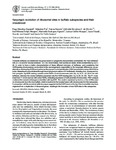Use este identificador para citar ou linkar para este item:
http://www.alice.cnptia.embrapa.br/alice/handle/doc/1001173| Título: | Karyotypic evolution of ribosomal sites in buffalo subspecies and their crossbreed. |
| Autoria: | DEGRANDI, T. M.  PITA, S.   PANZERA, Y.   OLIVEIRA, E. H. C. de   MARQUES, J. R. F.   FIGUEIRO, M. R.   MARQUES, L. C.   VINADÉ, L.   GUNSKI, R. J.   GARNERO, A. del V.   |
| Afiliação: | Tiago Marafiga Degrandi, Universidade Federal do Pampa; Sebastian Pita, University of the Republic, Montevideo, Uruguay.; Yanina Panzera, University of the Republic, Montevideo, Uruguay.; Edivaldo Herculano C. de Oliveira, UFPA / Institute Evandro Chagas; JOSE RIBAMAR FELIPE MARQUES, CPATU; MARIVALDO RODRIGUES FIGUEIRO, CPATU; Larissa Coêlho Marques, UFPA; Lucia Vinadé, Universidade Federal do Pampa; Ricardo José Gunski, Universidade Federal do Pampa; Analía Del Valle Garnero, Universidade Federal do Pampa. |
| Ano de publicação: | 2014 |
| Referência: | Genetics and Molecular Biology, v. 37, n. 2, p. 375-380, Apr./June 2014. |
| Conteúdo: | Domestic buffaloes are divided into two group based on cytogenetic characteristics and habitats: the "river buffaloes" with 2n = 50 and the "swamp buffaloes", 2n = 48. Nevertheless, their hybrids are viable, fertile and identified by a 2n = 49. In order to have a better characterization of these different cytotypes of buffaloes, and considering that NOR-bearing chromosomes are involved in the rearrangements responsible for the karyotypic differences, we applied silver staining (Ag-NOR) and performed fluorescent in situ hybridization (FISH) experiments using 18S rDNA as probe. Metaphases were obtained through blood lymphocyte culture of 21 individuals, including river, swamp and hybrid cytotypes. Ag-NOR staining revealed active NORs on six chromosome pairs (3p, 4p, 6, 21, 23, 24) in the river buffaloes, whereas the swamp buffaloes presented only five NOR-bearing pairs (4p, 6, 20, 22, 23). The F1 crossbreed had 11 chromosomes with active NORs, indicating expression of both parental chromosomes. FISH analysis confirmed the numerical divergence identified with Ag-NOR. This result is explained by the loss of the NOR located on chromosome 4p in the river buffalo, which is involved in the tandem fusion with chromosome 9 in this subspecies. A comparison with the ancestral cattle karyotype suggests that the NOR found on the 3p of the river buffalo may have originated from a duplication of ribosomal genes, resulting in the formation of new NOR sites in this subspecies. |
| Thesagro: | Genética |
| Palavras-chave: | Bubalino Evolução cariotípica |
| Digital Object Identifier: | http://dx.doi.org/10.1590/S1415-47572014000300009 |
| Tipo do material: | Artigo de periódico |
| Acesso: | openAccess |
| Aparece nas coleções: | Artigo em periódico indexado (CPATU)  |
Arquivos associados a este item:
| Arquivo | Descrição | Tamanho | Formato | |
|---|---|---|---|---|
| a09v37n2.pdf | 1,22 MB | Adobe PDF |  Visualizar/Abrir |









